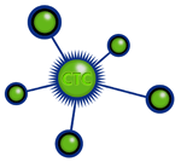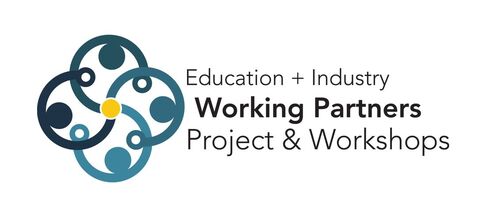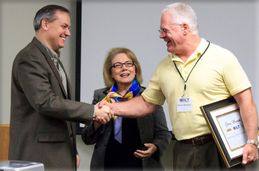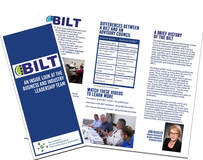|
Business and Industry Leadership Team (BILT)
ATE Center - National Convergence Technology Center, Collin College
Key Outcomes
- Established framework that deepens and validates industry involvement in program leadership
- Developed structures and processes that strengthen faculty-industry trust & cooperation
- Ensured curricular relevancy by regularly incorporating industry insights and knowledge
- Sustained intense industry engagement, often for years
- Disseminated model and supports adoption by other programs
Summary

The Business and Industry Leadership Team model, often referred to as "BILT", is a successful variation of the standard advisory board. Essentially, industry members – on a local or national level – agree to serve and participate as co-leaders of national and regional grant programs as well as college-level programs of study.
The BILT model was initiated by Ann Beheler, then Dean of Engineering and IT for Collin College who recruited from industry herself, when she found convincing industry professionals to get involved was made more difficult by their collective experience of providing input and expertise only to see it never implemented as curricular content. By assigning co-ownership of the program to both faculty and industry - and providing a structure and system for curricular co-development - the BILT model deeply engaged industry and kept them involved over time while creating vibrant pathways that produced work-ready graduates.
The BILT model was initiated by Ann Beheler, then Dean of Engineering and IT for Collin College who recruited from industry herself, when she found convincing industry professionals to get involved was made more difficult by their collective experience of providing input and expertise only to see it never implemented as curricular content. By assigning co-ownership of the program to both faculty and industry - and providing a structure and system for curricular co-development - the BILT model deeply engaged industry and kept them involved over time while creating vibrant pathways that produced work-ready graduates.
|
This model of co-ownership also supports each side of the partnership in doing what they do best. Industry members, drawing from their experience and sector acumen, provide insights into industry trends and future workforce needs. Program faculty and administrators use their knowledge and skills to transform that input into updated materials and curricula. These curricular changes are, in turn, presented back to the BILT for discussion and review. In this way, symbiotic, mutually respectful relationships are established between industry and faculty producing strong, workforce-aligned programs.
|
"Businesses will say: 'Here's what I want graduates to know at the end'. How they get there is up to faculty." Ann Beheler, National CTC Director/PI |
|
The successes of the BILT model have encouraged its spread. Collin College - and eventually the National Convergence Technology Center, an NSF-ATE funded center based at Collin and founded to focus on IT and Communications - partnered with other college IT programs and grew a formal peer network of 70+ colleges, each with a local BILT but also benefitting from the insights and labor market forecasting of the national CTC BILT. In addition, the BILT model has been adopted across sectors; as of this writing, the model has been incorporated by programs in cybersecurity, instrumentation, manufacturing, engineering technology, geospatial technologies, and more.
|
The BILT model calls for quarterly meetings; three are held via web conference call to obtain trends information from the businesses, and there is one in-person meeting held annually. It is during the one face to face session that the industry team reviews the knowledge, skills and abilities (KSAs) that are key for securing and maintaining employment 12-36 months in the future. Faculty and staff review the resulting in-depth recommendations, identify gaps and obsolete topics in the curriculum, ensure necessary topics are covered in enough depth, and weigh the practicality of incorporating other industry team recommendations. The results of the faculty work are brought back to the industry team for feedback, clarification and discussion. Eventually, the program shares the "layout of which courses are in what certificates and what degrees" and solicits input on these pathways in terms of employment opportunities and right skills. This iterative process is repeated annually with the web-based calls used to continue the dialogue and for industry to report on emergent trends.
Also critical to the long-term success of a BILT is that the program lead identify and periodically revisit the key motivator for involvement – the "what's in it for me" or WIIFM – for each industry team member to ensure that that motivation is being met. As Dr. Beheler notes: "I never ask them what's in it for them. I talk to them at length and, in conversation, they tell me. And maybe they don't even know that they told me....You have to listen to what they are saying when you touch base or when you ask them to join."
|
The National CTC continues to expand its repository of available information about the BILT model; the latest efforts include a recorded webinar as well as an extensive BILT toolkit detailing how BILT works and how to implement it for your program. The team also presents on the BILT model at technical education conferences and provides consultations with institutions and consortia who wish to replicate the BILT model. If you'd like to learn more, please please visit the BILT website (see "Additional Resources" below). |
Impacts
- Program co-ownership
The structure of the BILT model rests on shared ownership by industry and faculty of the program. Both groups equally contribute to program direction, focus and scope. - Right-skilled graduates
Industry annually reviews and renews the key knowledge, skills and attributes necessary for obtaining and staying employed in their field looking 12-36 months into the future to allow for curricular change; this better ensures graduates are job ready. - Advance notice of workforce trends
Early notice of technological developments and workplace change is provided by industry, allowing programs to more accurately anticipate future workforce needs and preemptively revise curricula.
- Faculty currency
Faculty are better able to identify gaps both in the program and in their own skillset; often industry team members provide faculty mentoring and offer free professional development to bridge these gaps. - Student-employer connections
Dedicated industry and business team members provide increased opportunities for student-employer mentoring, internships and employment.
Challenges
- Overcoming negative industry expectations
It can be difficult to convince industry members – who are accustomed to joining advisory committees, providing time, input and advice, and seeing little to no implementation of their recommendations –that their input will be heard and acted upon. .
|
"What faculty do to keep this relationship going is honor the recommendations made and come back with feedback...about the only thing that is not a good answer for why you can't implement is 'I don't want to.'" Ann Beheler, National CTC Director/PI |
- Ensuring the "right mix" on the team
Locating the right people within companies, ensuring that the team faithfully represents the sector, and making sure that, as team member availability fluctuates over time, the industry team continues to reflects the sector can be difficult. . The National CTC tries to add a new BILT member quarterly to keep input fresh. - Maintaining individual relationships
Industry motivations for staying involved with a program vary from person to person and can fluctuate over time. Program leadership must stay current with individual members which can be demanding.
Implementation Strategies
|
"Everybody wants graduates to be right-skilled and in high demand and to get a job as soon as possible...and the BILT concept works, regardless of industry." Ann Beheler, National CTC Director/PI |
- Meet quarterly, with one meeting in-person
Quarterly meetings permit true co-ownership and relationship building. The in-person meeting doubles as an annual industry review of the knowledge, skills and abilities (KSAs) necessary for obtaining and maintaining employment in the sector. - Streamline the annual review of knowledge, skills and abilities (KSAs)
Originally, the industry team was asked to go through allindividual outcomes for the program; this took at least two days. To better fit busy schedules, the process was streamlined by grouping KSAs into "big knowledge areas" with deeper conversations into those areas.
- Don't shortcut the process
Until you've been through it at least once.
- Recruit new members by print mail or by phone
Emails get lost in the mass of emails received by busy industry members; use print mail (hand-stamped and hand-addressed to attract interest) and by phone. And if someone can't join, ask if there is someone else they can suggest.
- Provide opportunities for industry to meet and mentor students
This can amplify the impact of industry and also encourage their involvement.
Additional Resources
Subject Information
|



